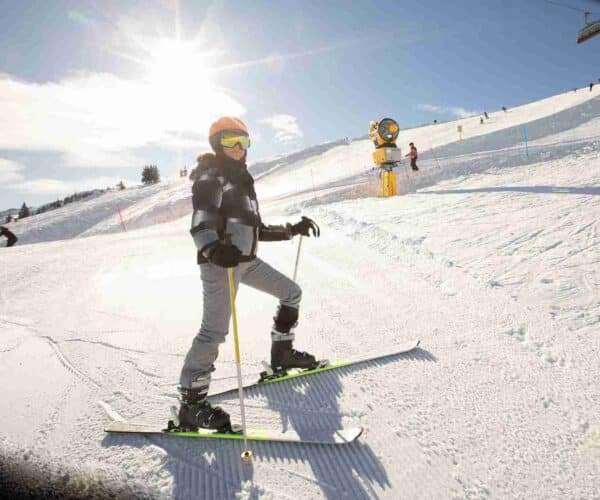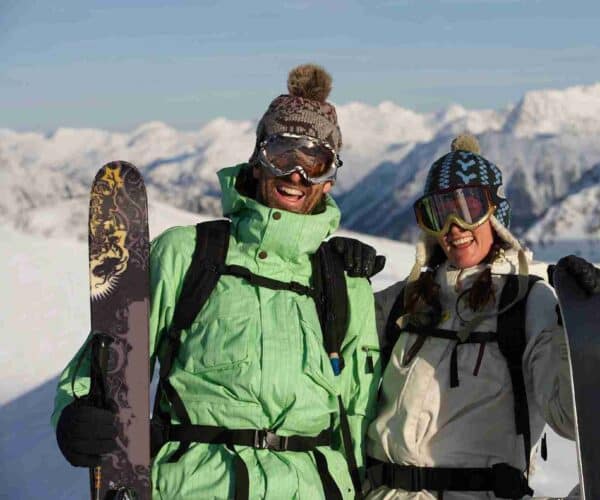Skiing is an exciting winter sport, but while you glide down the winter slopes, you might not realise how much sun exposure you’re getting. Many skiers underestimate the power of the sun in cold conditions, leading to painful sunburns. In this guide, we’ll explore why skiers are prone to sunburn while skiing, the necessity of sun protection, what UV protection you need, and how to treat sunburn if it happens.
Why do skiers get sunburnt so easily?

Skiers are at an increased risk of sunburn due to a combination of altitude, reflection, and prolonged exposure to the elements. Here’s why:
Higher altitude:
The higher you go, the thinner the atmosphere becomes, meaning there is less protection against ultraviolet (UV) rays. UV exposure increases by about 10% for every 1,000 meters above sea level.
Snow reflection:
Snow is highly reflective and can bounce up to 80% of UV radiation back onto your skin, essentially exposing you to sunlight from above and below.
Cold weather misconception:
Many people associate sunburn with heat and assume they’re safe in cold temperatures. However, sun damage happens regardless of temperature.
Longer exposure:
Skiing often means spending several hours outdoors without shade, increasing UV exposure throughout the day.
Do I need to wear suncream when skiing?

Yes! Suncream is essential when skiing, even on cloudy days. UV rays penetrate through clouds and can still cause sunburn while skiing. Here’s how to use suncream effectively while skiing:
Choosing the right suncream:
Use suncream with at least SPF 30 or higher to shield against both UVA and UVB rays.
Water and sweat resistance:
Opt for a suncream that is water-resistant to ensure it stays effective despite sweating or snow contact.
Apply generously:
Cover all exposed areas, including your face, neck, ears, and even under your chin (UV rays reflect up from the snow).
Reapply frequently:
Suncream should be reapplied every two hours, or more often if you’re sweating heavily or wiping your face.
What UV protection do you need for skiing?
Besides suncream, additional protective measures can help shield your skin from harmful UV rays:
Wear UV-protective goggles or sunglasses:
Choose goggles with full UV protection to safeguard your eyes from glare and UV exposure and prevent ski goggle sunburn.
Use a face mask or buff:
Covering your face with a balaclava or neck gaiter can add an extra layer of protection, especially for your cheeks and nose.
Apply lip balm with SPF:
Lips are often overlooked but can get sunburned too. Use a lip balm with SPF 30 or higher.
Opt for a helmet with a visor:
A helmet with a visor can provide additional shade and reduce direct sun exposure.
Wear protective clothing:
While most ski gear covers your body, make sure your jacket or base layers provide some UV protection if you plan to ski with your jacket unzipped or without a full face covering.
Additional Tips for Sun Protection on the Slopes

Beyond wearing suncream and protective gear, there are other steps you can take to minimise sun exposure while skiing:
Time your ski sessions wisely: The sun’s rays are strongest between 10 AM and 4 PM. Try to ski earlier in the morning or later in the afternoon to reduce exposure.
Seek shade when possible: While skiing, take breaks in shaded areas, such as tree-covered trails or ski lodges, to give your skin a rest from direct sunlight.
Educate yourself on UV levels: Some ski resorts provide daily UV index reports, checking these can help you prepare accordingly and take extra precautions on high-risk days.
Sunburn vs windburn
Skiers can easily get confused between sunburn and windburn, so lets break it down. Sunburn and windburn are both common for skiers, but they have different causes and symptoms. Sunburn occurs when your skin is overexposed to UV rays, which can result in redness, pain, and peeling after a few hours. On the other hand, windburn happens when cold, dry air strips moisture from your skin, leaving it red, tight, and irritated. While sunburn usually feels warm to the touch, windburn can feel dry and rough. For sunburn, it’s best to apply aloe vera gel or a soothing after-sun lotion and keep hydrated to promote skin healing. For windburn, use a rich, hydrating cream to lock in moisture, and protect your skin from further exposure.
How to treat sunburn from skiing
If you do get ski sunburn, it’s important to treat it promptly to minimise damage and discomfort:
- Move out of the sun: Move indoors or cover up to prevent further sun exposure.
- Cool the skin: Apply a cool compress or take a lukewarm shower to soothe the burn.
- Moisturise: Use aloe vera gel or a hydrating, fragrance-free moisturiser to help the skin heal and prevent peeling.
- Stay hydrated: Sunburn can dehydrate your body, so drink plenty of water.
- Avoid further irritation: Do not exfoliate, pick at peeling skin, or apply harsh creams.
- Use over-the-counter relief: If your sunburn is painful you can take ibuprofen to reduce inflammation.
- Monitor for severe symptoms: If you experience blistering, fever, chills, or nausea, it’s advisable to seek medical attention.
Conclusion

Skiing under the sun can be just as hazardous to your skin as lounging on a beach. High altitudes, snow reflection, and prolonged exposure all contribute to a high risk of ski sunburn. To stay protected, always wear suncream, use proper UV gear, and cover up as much as possible. If you do get burned, treating it quickly can reduce discomfort and speed up healing. With the right precautions, you can enjoy the slopes without the pain of a sunburn!
Get Ski Insurance from SportsCover Direct
Sunburn from skiing, though often overlooked, can be severe enough to require medical attention, making insurance even more essential.
Having the right insurance isn’t just about peace of mind – it’s a critical safety net. From covering medical emergencies and equipment damage to providing assistance in case of evacuation, proper insurance ensures you’re fully protected before you hit the slopes.
A specialist winter sports policy will provide comprehensive coverage so you can focus on skiing without unnecessary worries. SportsCover Direct’s ski insurance offers essential coverage for incidents such as cancellations, personal accident, search and rescue, medical expenses, lost or stolen baggage, and more.
This blog has been created as general information and should not be taken as advice. Make sure you have the correct level of insurance for your requirements and always review policy documentation.